

 The South African
The South African
by I Cornelius
Most history books which refer to 'the Battle of the Nile', usually
describe the battle that was fought in A.D. 1798. In that year Horatio
Nelson, the hero of Trafalgar (1805) defeated the fleet of Napoleon at
Aboukir Bay (near Alexandria).
However, centuries before, another battle was fought on the Nile; when
the ships of pharaoh Ramses III repulsed a sea invasion by the 'Peoples
of the Sea'. This battle has been described as 'the first naval battle
in history'.
Historical Background
The so-called 'Peoples of the Sea' or 'Sea Peoples' were of mixed ethnicity and presumably originated from the Aegean Sea and islands such as Sardinia and Crete. They were known under such names as the Tjekker, Sherden (Sardinia) and the Philistines. In the 13th century B.C. they invaded the Middle East from the eastern Mediterranean, surging like a flood through Anatolia (Turkey), Syria and Palestine. Only the armies of the pharaohs succeeded in halting them at the eastern gates of Egypt. They also attacked from the west via Libya, but were consequently repulsed.
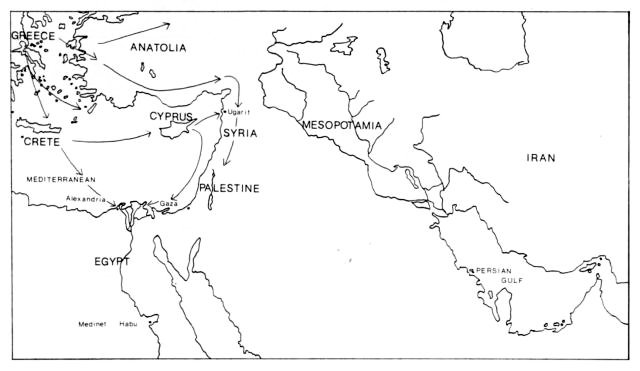
THE INVASION OF THE SEA PEOPLES IN THE ANCIENT NEAR EAST
(i) A group of 'Sea Peoples' infiltrated Egypt as pirates and were surprised
and repulsed by the Egyptian forces.
(ii) A group of 'Sea Peoples' invaded Egypt from the sea and were met in
battle by the Egyptian navy.
(iii) A 'Sea Peoples' naval contingent, accompanying the land forces made
an attack on Egypt and met the Egyptians in battle as indicated in (ii)
above.
There is sufficient evidence that the 'Sea Peoples' indulged in piracy.
It seems, however, more justified to argue that the conflict that occurred
was the result of an invasion from the land and the sea. Pirates usually
attack at random and are not accompanied by land forces.
The historical situation can be reconstructed as follows: A group of ships
of the 'Sea People' approached Egypt by one of the estuaries in the Nile
delta. The Egyptians, forewarned of this, prepared a trap and consequently
launched a surprise attack on the invaders. As will be shown below in the
discussion of the non-written material, the 'Sea Peoples' were attacked
before they could use their oars to escape.
Sources
The sources dealing with this naval battle are first of all epigraphic, the Egyptian royal inscriptions. However, these sources are highly idealized and stereotyped. Much more detailed information concerning this battle is supplied by artistic representation. The naval battle under discussion is depicted in sculptured relief on the walls of the famous temple at Medinet Habu in Egypt(2). This relief, which contains the first depiction of a full scale naval battle in world history, will serve as the main historical source in this short discussion (fig. 1).
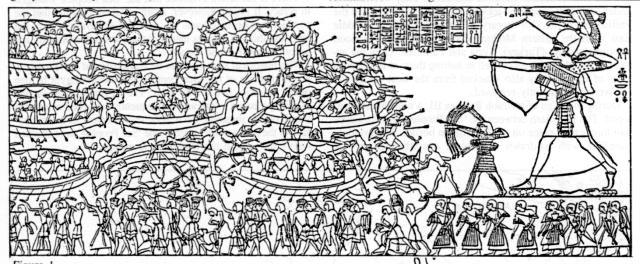
Figure 1
The Battle
Ramses III boasts in his inscription: 'They cut off their land and
were coming, their soul finished. They were warriors on land, another (group)
was on the sea. Those who came on land were overthrown and killed.'
This is an indication that one group of 'Sea Peoples' came by land but
were defeated. Another group attacked Egypt from the sea, navigating the
Nile.
Ramses III continues: 'Those who entered the river-mouths were like
birds ensnared in the net...'
He prepared his ships: 'I have the river-mouths prepared like a
strong wall, with warships, galleys and coasters, equipped, for they were
manned completely from bow to stem with valiant warriors carrying their
weapons'. As is to be seen in fig. 1, the battle raged on water, as
well as on land. The visual representation depicts the battle on water,
while on the right hand side archers are attacking from the land. The divine
pharaoh is also visible (depicted as a giant), leading the attack on the
notorious 'Sea Peoples'. It is of course not certain that he took part
in the battle and the representation of his person is probably symbolic.
This is reflected in verbatim: 'Those who came forward together on the
sea, the full flame was in front of them at the river mouths, while a stockade
of lances surrounded them on the shore...'
The textual evidence quoted so far provides only vague information
concerning the battle. Much more detail can be obtained from the relief
(fig. 1). The most important contribution that this relief presents is
the temporal order of the naval battle. Fig. 2 contains a pictorial narrative
of the battle in four stages:
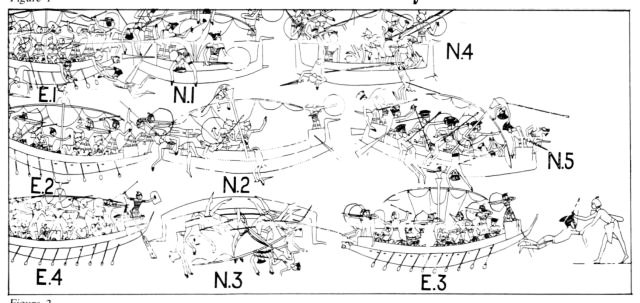
Figure 2
(i) The commencement of the battle (E.l and N.l): the Egyptian ship
is engaging the enemy. The invading vessel is still intact and level in
the water. The Egyptians have just started their attack, throwing grappling
hooks into the sail and boarding the enemy ship.
(ii) E.2 and N.2: the battle is proceeding. The mast and crow's nest are
toppling down after having been pulled down (i). One Egyptian spears an
enemy soldier and the Egyptian ship is already filled with enemy captives.
It is interesting to note that the captives are watching the fight, so
as to await the outcome (and their destiny).
(iii) The Egyptians are gaining the upper hand in the third stage (E.3
and N.3). The enemy vessel has capsized, with a broken mast and the invaders
are flung into the water. The 'Sea Peoples' have been defeated and the
Egyptians are the victors as can be seen by the prisoners in ship E.3.
(iv) With victory achieved, E.4 returns to the land, laden with prisoners.
On the prow an Egyptian officer prepares to embark and to lead his prisoners
before the pharaoh. Take note that ships E.1, E.2 and E.3 (in the attacking
position) have the lion's head in front. E.4 is turned around because it
is on a peaceful return mission.
The defeat was total. In fig. 1 some invaders try to reach the shores
but are slaughtered by the Egyptian soldiers. On the two registers below
the prisoners are led away while the royal attendants and bodyguards are
visible on the right. This is complemented by the written sources: 'They
were dragged in, enclosed, and prostrated on the beach, killed, and made
into heaps from tail to head. Their ships and goods were as if fallen into
the water'.
The detail concerning the ships and the fighters as depicted on the
relief (fig. 1), needs more attention. Before proceeding, it has to be
borne in mind that the depictions of the ships and fighters are highly
typical and stylized. Only one type of ship is depicted and it is not certain
that 'warships, galleys and coasters' took part as reflected by the text
cited above. Nevertheless, from the depiction some knowledge can be obtained
in connection with the ships used by the Egyptians and the 'Sea Peoples'.
The same is true of the crews, who are typical, but reflect ethnicity and
also information of the weapons used in combat.
The Ships(3)
Nine ships are shown in the relief (fig. 2), five belonging to the 'Sea
Peoples' (N.l, N.2, N.3, N.4 and N.5) and four Egyptian ships (E.l, E.2,
E.3 and E.4). Fig. 3 is a representation of an Egyptian ship that took
part in the battle, supplying evidence concerning the appearance of the
Egyptian warship during this period.
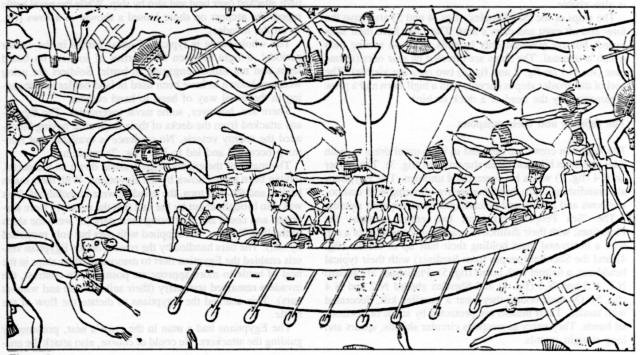
Figure 3
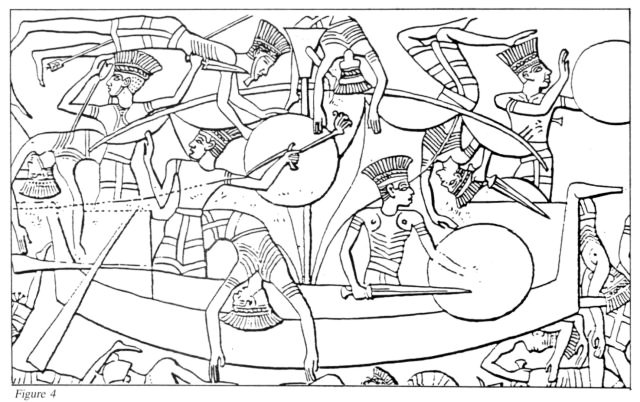
Figure 4
The fighters and their weapons
The Egyptian crews are depicted in their usual dress - with wigs and
linen kilts and clean shaven faces (fig. 3). The officer on E.4 (fig. 2)
wears his ceremonial uniform. The Egyptians are brandishing clubs, handling
spears, shooting with composite bows and arrows and defending themselves
with shields.
The 'Sea Peoples' represent two ethnic groups: the Philistines, with their
distinctive headdress, consisting of a cap with a horizontal band holding
their hair up in the air (fig. 4)(4) and the Sherden (people from Sardinia)
with their typical headdress, a helmet with horns (fig. 5). Philistines
are aboard N.l, N.3 and N.5 (fig. 4) and Sherden aboard N.2 and N.4 (fig.
5). On their bodies they wear a panelled kilt, decorated with tassles.
Their breasts are protected by strips of horizontal bands. They carry as
weapons circular shields, spears and long straight swords.
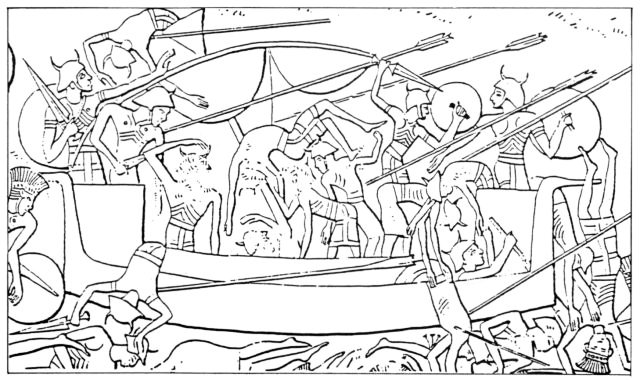
Figure 5
Naval Battle Strategy
As mentioned previously, a double battle occurred. The Egyptians attacked
over land and also by ship. While the naval battle raged, the archers on
shore loosed a shower of arrows (fig.1) on the invaders.
The whole battle is typical of naval battles in the earlier periods(5),
a fight between two parties of soldiers on board ships and not sailors
engaging in battle. Soldiers are using weapons known to have been used
in land battles and engaging in the usual way of hand to hand combat.
There are, however, some naval ingenuities. The Egyptians attacked from
the decks of their ships after having blockaded the enemy vessels. No evidence
is available that ramming occurred and led to N. 3 (fig. 2) capsizing.
The masts of the enemy ships crashed down on the decks, having been pulled
down by the Egyptians. With their masts broken and the sails torn, the
invaders were immobilized. This was also brought about by the fact that
the invaders were surprised and could not start using their oars (or were
the ships of the 'Sea Peoples' not supplied with oars but only propelled
by sail). The oars handled by the rowers on the Egyptian vessels enabled
the Egyptian fleet to manoeuvre their ships in the heat of battle to more
appropriate positions. In contrast, the invaders remained stationary (their
sails furled and without oars). This enabled the Egyptians to dictate the
flow of the battle.
The Egyptians had a man in the crow's nest, presumably guiding the attackers.
He could of course, also attack the enemy from this favourable height with
a sling (this is well known from medieval naval battles).
To sum up: the Egyptians trapped the 'Sea Peoples' in the Nile delta, the
sails of whose ships were furled. They grappled the invader ships, immobilizing
them; soldiers boarded their ships and attacked the enemy whilst archers
on shore supplied fire power. The use of archers (on sea and on land) provided
long range fire power and helped the Egyptians to overwhelm the 'Sea Peoples'.
Conclusions
The question may be put of what historical value are these sources that
have been used in the reconstruction of the battle? It is typical of the
Egyptian pharaohs as presumed 'divine' kings, to boast and sometimes even
to change near defeat into total victory.(6)
It is certain that a fight did occur on the Nile in the 12th century B.C..
The defeat was not so overwhelming as the Egyptian writers and artists
wished it to be. The 'Sea Peoples' were defeated and repulsed, but not
annihilated. They eventually settled in Palestine and one of the groups,
the Philistines, were met by the people of Israel. In fact, they even eternalised
their presence by giving this region the name by which it is known today
(Palestine).
The naval battle described provides many facts concerning ships and naval
strategy during this early period. 'The Battle of the Nile', fought in
1190 B.C. thus remains an unique event in the history of Egypt and also
of war at sea!
Footnotes
Sources of the Illustrations
Acknowledgement is given for permission granted by the publishers for
the use of the following illustrations:
fig. 1. A. Erman & H. Ranke, Aegypten and aegyptisches Leben im
Altertum, (Tubingen, J.C.B. Mohr (Paul Siebeck), 1923), p 648 (Abb
269).
fig. 2. H.H. Nelson, 'The Naval Battle Pictured at Medinet Habu', Journal of Near Eastern Studies, II/ 1, (Chicago, University of Chicago Press, 1943), pp 40-55, fig. 4.
fig. 3-5. Y. Yadin, The Art of Warfare in Biblical Lands in the Light of Archaeological Discovery, (London, Weidenfeld & Nicholson, 1963) pp 250-252.
All translations are taken from J.B. Pritchard (ed.), Ancient Near Eastern Texts Relating to the Old Testament, (Princeton, Princeton University Press, 1969), pp 262, 263.
BIBLIOGRAPHY
Return to Journal Index OR Society's Home page
South African Military History Society / scribe@samilitaryhistory.org